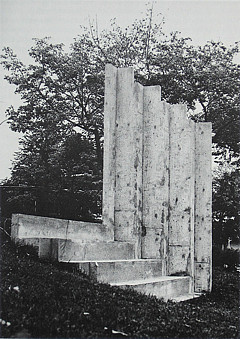SPECULATE TO APPRECIATE
This article was published in Vanguard Magazine, in December 1984, and was prompted by my critical reaction to the catalogue introduction that accompanied the exhibition, Gerald Ferguson: Works 1978 to 1984, at the Dalhousie University Art Gallery during October–November of that year.
It is important to note that the exhibition, which was later to travel across Canada, was accompanied in Halifax, by a parallel show with the title Landscapes and Seascapes, at the Anna Leonowens Gallery of the Nova Scotia College of Art and Design – which, though it was composed of a series of oils by the well known painter Gerard Collins who worked from postcards chosen by Ferguson, was offered as one single art work by Ferguson (in collusion, of course, with Collins), with the intent that the two shows should be discussed together.
The above title, “Speculate to Appreciate” was (obviously, I hope) a double entendre pointing both to Ferguson’s ironical comment, through his art of that period, on the speculative art market and the financial appreciation of the artworks within it, and to the lack of critical speculation and appreciation of the show by the author of the catalogue.
Today, thirty years or so later and after many cogent reviews of his work in the Canadian press, Gerald Ferguson’s art can be seen to have evolved through four rather different, though well-connected, periods. These periods, I now suggest, can be found discussed in four texts, the first being my essay of 1977 accompanying the exhibition of his early works, at the Dalhousie Art Gallery (and found elsewhere on this site); the second being the text below, of 1984; whilst what I would call his third and fourth periods are discussed in two very fine essays—the first of which and the best illustrated, also published by the Dalhousie Gallery and titled Gerald Ferguson Compositions 1989–1994, is by Susan Gibson Garvey and would cover his third period, whilst that covering his late period is discussed in “Late Style in the Work of Gerald Ferguson,” by Diana Nemiroff, former curator of contemporary art at the National Gallery of Canada, in the Journal of Canadian Art History, Vol. 21, No. 1, (2000)
SPECULATE TO APPRECIATE
When Gerald Ferguson's first large exhibition took place, in 1977, in Halifax and Toronto, I was convinced that his various skirmishes into conceptual aesthetics were in the service of discovering how it might still be possible to paint in the last quarter of the 20th century. The present exhibition reveals that I was mistaken. Indeed, Ferguson has not made a painting since, or at least not one which comes close to the literalism in which he was then active. Instead, he seems to have been diverted into the byways of deconstruction.
The turning point was evidently a painting made in 1978 in the spirit of his characteristically literal, task-oriented art, but which was subsequently seen to invite recasting. This was a work called In Anticipation of Changing Values, made by filling in small circles on a piece of newsprint with a colour that the newsprint might eventually come to match by virtue of its oxidation. There had been a “one off” work, a drypoint of 1972, done with a deliberately metaphorical overlay, which was made, as the title suggests, by taking the burin Close to the Edge but Not Going Over the Edge; but the present thrust seems to have come when the work called In Anticipation of Changing Values began to resonate with an earlier piece, Five Grams of Gold, created for a 1973 show of Douglas Huebler’s, of pieces by other artists to be exchanged for works of his valued at $150 (the fact that five grams of gold then cost only $21.25 U.S. was explained away by Ferguson’s statement, that came with the work, that it would nevertheless be worth $150 at some time in the future!). The theme that becomes slowly manifest through these two pieces, leaping over a six-year span of quite different preoccupations, seems to displace the ironic self-consciousness of Close to the Edge and to assert the beginning of a meditation on art as a commodity and on the mythos of exchange value that surrounds it—a new opus that significantly re-contextualizes the two source pieces in the lineage of Marcel Broodthaers (but without his literary trappings, and through the literalist painter's eye).
It is unfortunate for the cohesiveness and even the comprehension of the present show, however, that the catalogue essay presents it as a meditation on value conceived in various other dimensions (“colour values,” “the value of experience,” “historic value,” “commercial value,” “aesthetic value,” “financial value” and “objective value’). The writer has identified the target, but such a charge of buck-shot does not penetrate to the heart of the matter. Let me give some instances of the kind of confusion that thereby ensues.
In evoking associations to In Anticipation of Changing Values, the catalogue asserts that the physical changes on which the work plays at the literal level, translate as an allegory of the way aging affects human beings—for instance, “maturation or decline” (but are they mutually exclusive?). The real trouble with this, however, comes when, later in the essay, it is pointed out that in fact the newspaper darkened even more than was “anticipated.” In a thoroughgoing exegesis, this would confirm that decline may not only follow maturity, but follow it in an unpredictable and perhaps tragic way. Not only is this serendipity not perceived, however, but the introduction settles for an interpretation based on a face-lifting cliché from Ann Landers: “He's not getting older, he's getting better.” Flying this kind of kite over the work simply will not do.
What is being allegorized, in In Anticipation of Changing Values, is literally exchange value, for of exchange value, in regard to art, we can indeed say that it “gets better” paradoxically as the piece “gets older.” And this is a premise actually stated by Ferguson in a folder published by the Glenbow Museum in 1980 when he exhibited there his work One Million Pennies. That Ferguson made the 1973 piece for Huebler literally in this spirit is crucial
Elsewhere, the catalogue suggests that Ferguson's “Postcard” (a photo of Halifax City Hall marketed as a card by Ferguson in 1979) directs our eyes to the changing verdigris on the copper covered steeple.

The idea, says the introduction, is to alert us to something called “historic value.” What is to be construed from this however, can be no more than “history” as conceived by the sentimental tourist brochures of “Canada's Ocean Playground,” the kind of history that Barthes, for instance, identifies as a myth—the very myth indeed that the deconstructive enterprise sets out to undermine through actual historical analysis. The ironical fact is that, had this been understood, the pointers to a decoding consistent with Ferguson's emerging direction were available in the works I have already mentioned, for the allegory of “changing values” enshrined in the postcard photo of the copper spire is surely that which encodes the City Hall in its aspect as a gambling casino—where the chips are exactly those huge chunks of real estate subject to its volatile zoning regulations.
The introduction is no help either when we come to the so-called “Maintenance Paintings” (all monochromes offered for sale at $10.00) which it validates as standing for a “workman-like good repair”—something which is actually held to be foreign to the Western tradition of fine art—an assertion that is surely untenable, for “maintenance” has been a part of the tradition since time immemorial—and is assumed in all art transactions (specialists exist, for instance, whose sole occupation is the restoration of the works of Frank Stella). But whether “maintenance” is within the tradition or not, the first and most obvious decoding of it, in Ferguson’s emerging allegorical structure, is that it stands for the reactionary impulse to preserve the status quo: to hold that nothing changes in “Paradise” and to paper over ruptures in the mythic structure of ideology as new social forces press upon it.

In other words, the title must be seen, above all, as a reference to the ideological “maintenance” that goes on at City Hall. Why? Because, ironically, as Postcard demonstrates, the masters of Halifax City Hall have actually had its window casings painted green to keep up, so it seems, with the changing verdigris of the spire! The first Maintenance Paintings were therefore in green monochrome, and the idea appears to have been, initially at any rate, to encourage the owners, via a “certificate of ownership,” to rehearse the facts and fictions of City Hall by “maintaining” their paintings too—perhaps even bringing painterly realism to a reductio ad absurdum by heroic efforts to keep up with the actual paint each time the window cases of City Hall get recoated!
However, if this was indeed what was projected, then before it could be realized the artist seems to have directed the work to another end: first by defining or re-defining the word “maintenance” to include the idea of “re-painting,” second by addressing the certificate not to an owner but to an “end user,” and third by creating other monochromes in a variety of colours—and unfortunately what this finally brings us to is not a single syncretic work but two separately viable ideas obfuscated deliberately it would seem by a single dubiously syncretic title.
For, what the extended phraseology amounts to, if “maintenance” is to mean “repainting,” is a strategy for wrenching the work of art from the domain of commodities and exchange value in favour of a return to something like “use” value. It may be argued that such an enactment could be nothing more than a parody of naive nineteenth century jargon, not only because we now understand the seamless relationship between use value and exchange value, but because the “use value” of art inheres in the realm of the symbolic rather than in that of the instrumental (1). Still, the average individual can see that something is going on—and when it comes to an option of re-painting, we can literally visualize the obliteration of the symbolic along with exchange value in favour of the instrumental: the “art” canvas now painted over to fit perhaps with a scheme of decor (as, for instance, when Whistler painted peacock blue over the Spanish leather of Leyland's dining room walls). This interpretation, the polar opposite of “maintenance,” has the advantage of recruiting these paintings to the programme of “accommodation to changing realities” stressed as the theme of the show in the Dalhousie Art Gallery's advertisement of it, in a way that “maintenance,” except by lexicographical confusion, cannot.
Equally in compact with the copper spire of City Hall is One Million Pennies, conceivcd in 1979, realized at the Glenbow Museum in 1980, and documented in the present show by a large colour photograph.
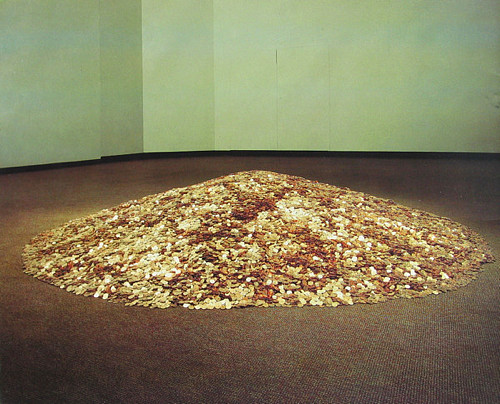
The work has first of all, however, an interesting relation to Ferguson’s painting in the middle 1970s based on templates that now remind us of the negatives from which discs about the size of pennies might have been punched, and more importantly it invites pondering in purely formal terms: its aggregate of spectacular colours, its shape conditioned by natural forces, its six thousand pounds of weightiness and the astronomical number of subtle variants that its mode of fabrication can engender, while it quite literally erodes the notion of integrity of form by inviting people to throw pennies onto it or to sneak some away from it—a volatility which nevertheless lies beneath our threshold of perception. But the work is more than these matters of form, for by a process of caricature it too addresses some of the factors that contribute to the commodification of art.
In this respect, One Million Pennies is not only a coup de théatre, for it seems to be the one work that it is possible to make which conspicuously rejects the conditions of authenticity, uniqueness and scarcity necessary for a work of art to be relevant to a theory of commodities, while at the same time declaring an identity, like Five Grams of Gold, as both a commodity on the metals market and a token of al1 commodities in the profane world. The prescription for the piece, in the Glenbow Museum folder, aims at multiple ironies. It declares the work to be “one million pennies piled in the middle of a room” (though later it equivocates about this), and names a price for it of $10,000, implying absolute equity for the buyer and zero profit for the artist. Later it equivocates about this too, in an attempt to persuade a prospective buyer to pay the artist $10,000 and compensate him for the million pennies once their equivalent has been raised by investing their sum in a bank! We gather from this that the piece materializes and dematerializes according to need—spending most of the time in a dematerialized state, “stored” in a bank from which it might even be put into circulation and irretrievably scattered in its material form though conceptually capable of being re-integrated so long as the bank is prepared to recognize a difference between the token value of coins and the token value of bills (though, caveat emptor, this difference may not be recognized). In the circumstances, even though the present value of raw copper is less than half its value as pennies, we are brought to recal1 that Five Grams of Gold was once briefly worth six times what Ferguson paid for it, and to ask therefore whether storing the pennies in the basement of the owner's house might not provide a better assurance of its appreciation as well as of its material survival. The paradox itself seems less at stake, however, than the confrontation of the viewer with a lampoon of the difference between petit-bourgeois retentiveness and caution, and an upper-middle-class penchant for speculation in copper futures! The Glenbow folder furthermore leaves the viewer to consider that as art tout court the work might be deposited in a museum (understood as a bank in the political economy of art), or even, at some point put on the auction block. This last option, indeed, points, as no other art work could, to an extraordinary enactment of the scenario of art transactions as understood by Veblen's notion of the aristocratic wager and the signifying power of conspicuous risk. A clue to this possibility is to be found in another work of Ferguson's works, also only documented in the present show, made by scattering three thousand pennies about the floor of the Mount St.Vincent Art Gallery in 1983, as part of a collective show titled Appropriation/Expropriation. Whether the visitors got the point of “expropriation” or not, or whether they even noticed the pennies lying there, they were clearly being invited to take the money and run: a conceit that flatters Veblen over Marx and brings us by a brief chain of association to Baudrillard's Veblenesque For a Critique of the Political Economy of the Sign. What greater paradox, for instance, could be illuminated than the spectacle, evoked by One Million Pennies, of Veblen’s robber barons at an auction outbidding each other for a pile of money and bent to do so by the very structures of signification contingent upon their own place in society? And as for Veblen's substitution of the antagonistic struggle of classes for the agonistic competition of peers, what could more tellingly illustrate the willing subordination of the masses to the yoke of emulation than the spectacle of the queues that were formed daily to see the piece: to see a million—if only a million pennies. In Canada’s Alberta it almost restored the credibility of a zeitgeist! The compelling popularity of it was even signified by the C.B.C. whose proctoscopic cameras featured the installation on the National T.V. News, at prime time,
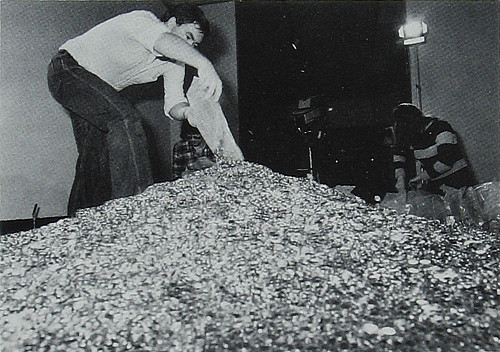
the pennies cascading from narrow plastic sacks in a way that might have once demanded a footnote in Erik Erikson—a regression not only back “beyond the horses of the Parthenon” but beyond even the “hobby-horse” of Gauguin's childhood, one might say, to that potty of gold tucked away at the end of the rainbow by our infant amnesia, in some El Dorado of the unconscious, some Las Vegas of the mind. As the videotape included in the present exhibition shows, even the zaniest Las Vegas slot-machine movie joke falls short of the jackpot indicated by this pulsating shower of coins—the profligacy of it was enough to inspire from your average anal-retentive viewer that familiar cry of Duchamp’s “Oh, douche it again!” A splendid if unforeseen resonance with the master from a piece otherwise indebted to him in more obvious ways (for instance, the pile of pennies gets its form from a variant of Duchamp’s Stoppages and we are reminded of his Musical Erratum by the fact that Ferguson's piece generates at least one million aleatoric notes each time it is installed—notes that also evoke the cries of Danae raped by Jupiter disguised as a shower of gold and, here, allegorical of the rape of art).
Parallel to the Dalhousie exhibition, Ferguson opened a second show at the Anna Leonowens Gallery of the Nova Scotia College of Art and Design, of landscapes and seascapes derived from commercial postcards of Nova Scotia and executed for Ferguson by Gerard Collins.
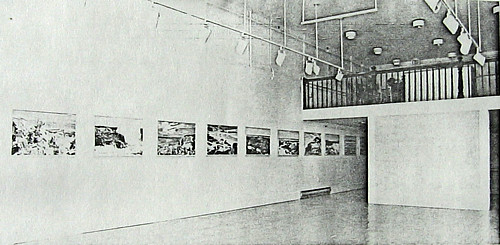
Redolent by this device with nostalgia for the return to value inherent in medieval workshop practice, these works nevertheless engage in a more complex conceit: the confrontation of Duchamp with Walter Benjamin over the power of “aura” in the institution of Art.
Duchamp, of course, implied that the mechanically reproduced art object could be given “aura” (what he called “a new thought for that object”) by a simple act of nomination, and One Million Pennies ultimately derives from this, but the spectacle of Walter Benjamin stood on his head and copulated with the French maître by a translation of the mechanically reproduced image into an authentic-looking, aura-laden yet inauthentic work is remarkable—for Collins's handling of the paint in this exhibition is of stunning virtuosity—and of course Collins is not, in any sense, a brush-for-hire, but a willing collaborator with Ferguson and has given of his best—nothing else would do—in the service of works rubricated as Ferguson's art.
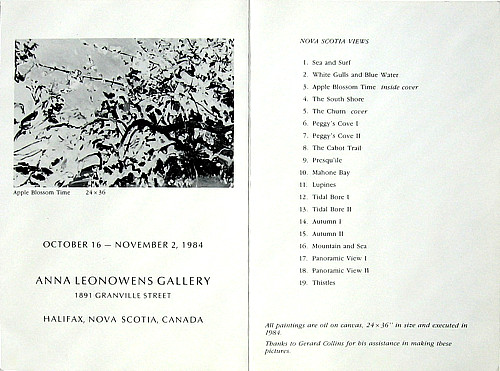
The tension set up by this exuberant blague is exquisite (close to the pain threshold for those who cling to pre-Duchamp values) and it is particularly important for this tension that Ferguson realized that it could be accomplished only by the painting and hanging of an entire exhibition, which he is justly showing as a single art work at a gallery other than the location of the rest of the works here reviewed.
Further to this contexting, however, when we pause to reflect beyond our aesthetic predicament confronted by these works, it is obvious that we have had thrust upon us questions about which the artist remains designedly tight-lipped. These are questions about just how Gerald Ferguson has in fact capitalized on the “surplus value” of Collins's labour. For Collins has undertaken to act out the role of the worker whose only commodity is his labour, which he sells to the owner of the means of production (Ferguson) at a rate that ostensibly creates capital for Ferguson – a situation that up-dates Duchamp's famous painted hand in Tu m’ or his signing of an anonymous painting at New York's Hotel des Artistes, to connote the state of industrial relations still relevant in Nova Scotia.
It is therefore a matter of surprise, in an introduction which claims in its first line that the artist is “concerned that value be given for effort expended,” that this matter should not be taken up. But not only does the introduction fail to do so, it clearly implies that the only “effort” at stake is Ferguson's own. This is entirely to miss the implication of the employment of Collins as a proxy: for, for example, however much off-stage thought Ferguson may have given to the work, and we shall never know how much or how little that might have been, it was surely in the service of an on-stage presentation of signifiers of the opposite: that the artist (Ferguson) has expended very little effort, as one might now expect from anyone creating, like Ferguson, in the sardonic tradition of Baudelaire’s threadbare dandy—in contrast, for instance, with the tradition of the petit-bourgeois who believes that value is displayed by conspicuous work and therefore buys “Maritime art” created in emulation of Alex Colville’s! Indeed, when the introductory essay is prefaced by two definitions of the word “work” taken from Webster, one cannot help the thought that its main aim is to apologize to exactly that stratum of society that sees value only in conspicuous labour. This is unfortunate for I am sure that it is not the author’s intention, for the author knows, as well as I do, that such people never read catalogues.

